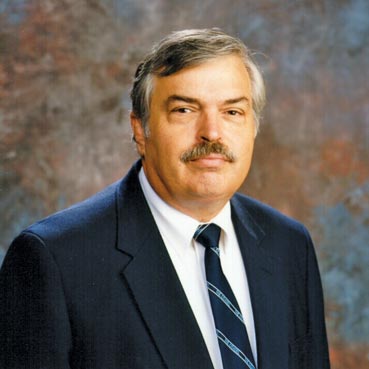 |
| Clayton Paul |
I recently had a chance to reflect on some of
the standout moments of 2005, which were memorable for me both
personally and professionally. While there are many events and
happenings that came to mind, I thought that one event we can
all share together was the Awards Luncheon at the 2005 IEEE International
Symposium on EMC in Chicago, and in particular, the tribute given
to our friend and colleague Clayton R. Paul - recipient of the
prestigious 2005 IEEE Electromagnetics Award. This was memorable
to me for several reasons.
On a personal level, I have known Clayton for nearly 30 years.
He was responsible for sparking my interest in EMC during the
early days when I wasn’t sure which branch of electrical
engineering to follow. Our first meeting took place when I was
a student/technical assistant working at the then Rome Air Development
Center (RADC - currently the Air Force Research Lab, Rome Research
Site). Clayton at the time was a post-doc research engineer assigned
to work on EMC problems for the Center’s Expert Sciences
Program. He and I supported some of the same projects and gave
training programs related to EMC analysis and prediction software
that was being developed by RADC at the time. His keen insights
into system-level EMC and cable crosstalk problems taught me a
great deal. His on-the-job tutelage both influenced and inspired
me to pursue the EMC engineering profession. He had a very casual,
but highly effective way of teaching EMC theory and EMI troubleshooting
methods, which to this day have served me well. Today I consider
myself reasonably successful and very happy with my professional
career choice. I owe much to Clayton for encouraging me to follow
this path. Thank you Clayton!
For me, knowing someone well who actually receives an often elusive
and much-sought after IEEE field service award, such as the IEEE
Electromagnetics Award, is both a high honor and a distinct privilege.
For those who don’t know the background of the award, it
is sponsored by the IEEE Antennas and Propagation Society, IEEE
Microwave Theory and Techniques Society, IEEE EMC Society and
IEEE Geoscience and Remote Sensing Society. Persons nominated
for this award represent the “cream of the crop” from
among these societies let alone the field of electromagnetic engineering.
The IEEE Electromagnetics Award was established by the IEEE Board
of Directors in 1996. It may be presented annually, to an individual
only, for outstanding contributions to electromagnetics in theory,
application or education. Recipient selection is administered
by the Awards Board through its Technical Field Awards council.
The Award consists of a bronze medal, certificate and a cash honorarium.
It is a highly sought after award and the process is very competitive.
Each of the participating societies nominates only one individual
from within its ranks to receive the award. The total process
of conducting the nominations, endorsements, and evaluations from
beginning to end involves a substantial effort and is closely
scrutinized at every level to determine whether the candidates
are qualified or possess the necessary credentials to even be
considered for this award. This is why we place such a high premium
on this award and specifically, in Clayton’s case, for putting
the spotlight on the EMC Society and for giving us an opportunity
to acknowledge one of our own for significant contributions to
our discipline. It is a great tribute to the man, the Society,
and the EMC engineering discipline in general. Bravo!
So, as 2005 ends and 2006 comes into fruition, I thought it would
be nice to once again congratulate our colleague and friend Clayton
Paul for all that he has accomplished, for a brilliant career
which thankfully flourishes to this day, and for future opportunities
to collaborate with him and learn from him.
I must say that when I first considered writing this article,
it was going to be strictly an expression of my own viewpoint.
After some thought, I came to the conclusion that the best tribute
article is one that contains testimonials from a few of his friends
and acquaintances.
Now, I COULD say that,
The IEEE and its predecessor societies have been recognizing outstanding
contributions for almost a century. With these awards, the IEEE
recognizes that these talented and brilliant individuals also
have helped to further the mission of the IEEE to promote the
creation of new technologies for the benefit of humanity and the
profession.
In 2005, we honored Dr. Clayton R. Paul, the Sam Nunn Eminent
Professor of Aerospace Engineering and professor of electrical
and computer engineering at Mercer University in Macon, Georgia.
Dr. Paul was recognized for excellence in the advancement of electromagnetic
theory towards solving crosstalk problems in transmission lines
and cable assemblies.
Considered by many to be a world-renowned authority in electromagnetic
theory, Dr. Paul has been responsible for many seminal advancements
in EMC. His contributions in modeling and quantifying interference
on cabling between systems have laid the foundation for today’s
benchmark methods used for assessing and mitigating EMI in complex
wire and cable systems.
He is professor emeritus of electrical engineering at the University
of Kentucky, where he served on the electrical engineering faculty
for 27 years. His course on EMC at this university was among the
first of its kind. He has published 15 textbooks and more than
150 papers and reports.
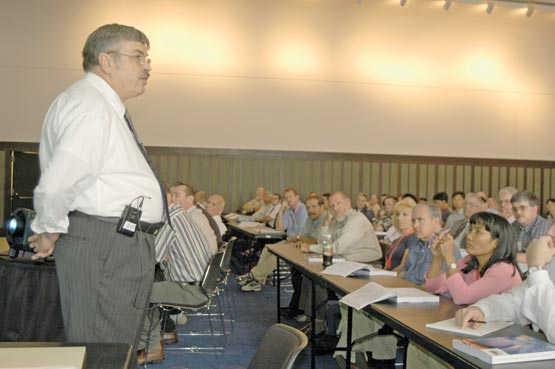 |
| During the 2005 IEEE International
Symposium on EMC in Chicago, Dr. Paul spoke to a rapt audience
on the “Fundamentals of EMC.” |
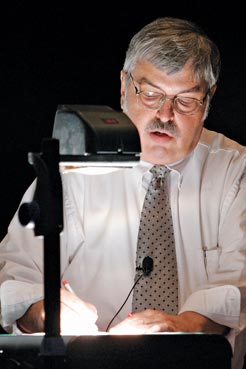 |
| Dr. Paul shown doing what he does
best – lecturing on his favorite topic (EMC) and marking
up diagrams to emphasize a point and provide the practical
“how to” details. |
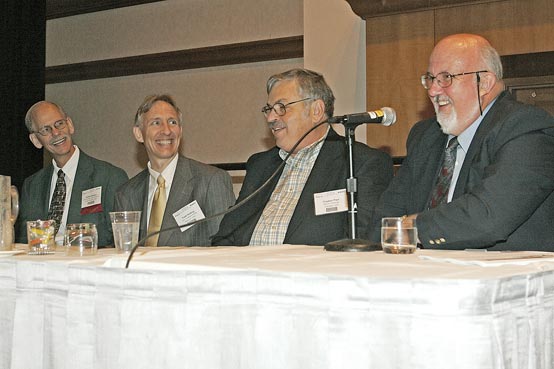 |
| Speakers always appreciate being
on a program with Clayton Paul. Enjoying the camaraderie of
“EMC Experts” in Chicago are (from left) Bob Nelson
of North Dakota State University, Todd Hubing of the University
of Missouri-Rolla, Dr. Paul of Mercer University, and Daryl
Gerke of Kimmel Gerke Associates. |
A Fellow of the IEEE, Dr. Paul is the only two-time recipient
of the IEEE Electromagnetic Compatibility Society’s Richard
Stoddart Award for Outstanding Performance. He is also an honorary
life member of the IEEE EMC Society.
He is an outstanding engineer, scientist, and educator, and is
highly deserving of the IEEE Electromagnetics Award.
BUT rather than hear it just from me, let’s listen to a
few of Clayton’s other friends and colleagues:
“During the long summers spent at the University of Kentucky
(UK) under the guidance of Clayton, I had the privilege of receiving
his technical and personal attention. This “Southern Gentleman”
(one of the best ways of describing Clayton that I ever heard)
not only taught me the solid fundamentals of MTL theory, but also
how to perform and develop the scientific research in our EMC
field. I’ll never forget the long talks, outside the EE
building, smoking pipe (him), talking about technical details,
things to do, to fix, to learn (me). But, what about when he decided
to bring me to JC Penny to buy a pair of short pants to “survive”
the hot Kentucky summer and relax my “formal” Italian
style? And his constant attention to the needs of others? His
driving me around the city (not only Lexington, but also, more
recently, in Macon) to find a Catholic Church for the Sunday mass
celebration. Clayton is also a great aerobatic pilot! He took
me flying several times while at UK and my wife still “blames”
him because when I returned to Italy, I decided to get my pilot’s
license. Very recently we went out together for rolls, spins and
loops. That’s Clayton! Thanks Clayton!! My only regret is
that my English may not sufficiently express all my gratitude
to him, but probably my Italian may not either!”
Antonio Orlandi, University of L’Aquila, Rome, Italy
“I have known Clayton for well over 15 years both as a colleague
in the IEEE EMC Society and in his role as chairman of the technical
program committee of the long running Zurich EMC symposium in
Switzerland. He has not only contributed to major educational
activities at the university level, but as a distinguished lecturer
for the EMC Society where his presentations on basic EMC theory
and low RF emission circuit design and practical applications
have brought out a large number of attendees well above the norm.
He is a “sell out” everywhere he goes which attests
to not only his in-depth knowledge, but the ability to communicate
it to those not as skilled in the EMC art and science as he is.
This is a trait that cannot be overlooked and places him in a
class by himself from my perspective. As chairman of the Zurich
EMC technical program for many years, he brought together widely
diverse EMC researchers and practitioners that literally spanned
many continents in a technical program that was the envy of Europe
in particular. The technical program of the Zurich symposia during
his term as technical program chairman was elevated to an extraordinarily
high standard and technical depth that in my opinion was directly
the result of his untiring work. You will find no better individual
that has the technical competency and the inherent ability to
teach and educate the EMC discipline based on electromagnetic
principles (his books on introduction to EM Fields and EMC are
still as relevant today as they were 20 and 10 years ago, respectively)
to students as well as those whose professional careers span decades.”
Donald N. Heirman, Don
HEIRMAN Consultants, Lincroft, NJ
“I have learned a great deal of my understanding about EMI/EMC
physics from Clayton Paul. He has the ability to explain complex
ideas in a way that makes these complex ideas easy to understand
without the need for messy mathematics. This has brought the understanding
of EMI/EMC to the point where typical design engineers can use
these concepts to improve their product design. It is a rare gift
for a university professor to be able to communicate and educate
working engineers. Clayton is one of the great minds in EMI/EMC.
He is respected by everyone, and this respect is well deserved.
Recently Clayton complemented me on a technical paper I had written.
Such praise from a person with the reputation and stature of Clayton
Paul was high praise indeed! His comments had me smiling for weeks.”
Bruce Archambeault, IBM,
Research Triangle Park, NC
“When I decided to leave industry to become a professor,
my principal goal was to develop and teach a course in EMC at
the university level. My obvious choice for a Ph.D. advisor was
Clayton Paul at the University of Kentucky. I had read his articles
in the Transactions, and they were the best blend of theory and
practicality I had seen. He not only pushed the understanding
of crosstalk to new levels by clever analyses; he also explained
his results in a way that made them easily applicable to my work
at Hewlett-Packard. Clayton was most gracious when I contacted
him about becoming his student, and was quite supportive of my
work during my three years at Kentucky. While serving as his TA
for his introductory circuits class, I learned many tricks of
the teaching trade that I use to this day at The Citadel. What
good fortune it has been for me to have the opportunity to know
and work with Clayton, and what a much greater fortune it has
been for the EMC community that Clayton chose this area for his
life’s work.”
Tom Jerse, The Citadel, Charleston, SC
“I remember Clayton’s trips to the EMC IAP Support
Center at RADC in the early 1980s and our discussions on bass
fishing. If he fished here, he caught nothing, while I had the
luck of the Irish. He then returns to warmer climates, buys a
bass boat, takes lessons, and manages to catch small crappie.
He, however, did learn that the use of DuPont lures was very effective
for catching fish. (That’s dynamite to the uninformed!).”
Clifford E. Carroll, Jr., ANDRO Computational Solutions, LLC,
Rome, NY
“I first met Clayton when I was a young engineer working
for IBM. He spent part of one summer working in our lab and I
was impressed by the fact that a university professor knew so
much about product design and evaluation. He was a major influence
in my own decision to pursue a career in academia.”
Todd Hubing, University of
Missouri-Rolla, Rolla, MO
“I first met Dr. Clayton Paul in the early 1970s. I was
a research engineer at the USAF’s Rome Air Development Center
in Rome, NY. Clayton was a new post doc from Purdue University.
Over the next twenty years, Clayton supported the USAF with his
in-depth knowledge, professionalism, and dedication. We worked
on many research projects together dealing with wire-to-wire coupling
and statistical modeling in EMC. Above all, I remember the late
nights working on the USAF’s Intrasystem EMC Analysis Program
(IEMCAP), teaching courses on IEMCAP across the USA, our NATO/AGARD
Lecture Series (116) on EMC and the numerous trips together supporting
the USAF’s Intrasystem Analysis Program (IAP). This award
could not have gone to a more deserving individual. Congratulations
Clayton from all your friends and colleagues in Upstate NY.”
Gerard T. Capraro, Capraro
Technologies, Inc., Utica, NY
“I have known Clayton for over 40 years, first as a student
at Georgia Tech, where he was my electronics course graduate teaching
assistant, and later as a good friend and long-time colleague
in the EMC Society. I recall Clayton most for his tireless work
over many years as the Technical Program Chairman for the EMC
Zurich Symposium and for our traditional Friday train ride around
Switzerland after the conference had ended and for #90 at the
Zeug Haus Kjeller. Thanks Clayton for all your hard work and the
many memorable experiences we have had together over the years.”
John Norgard, Air Force
Research Lab, Rome Research Site, Rome, NY
“‘Hi Clay.’ ‘Hi Dick.’ No extra
flourishes. Just a solid and warm greeting. But need some help?
Just ask him. Despite busy days, he’ll reply... respond...
even check it out for you. ‘Solid citizen’ kind of
says it…But that’s not quite enough. He’s quick
to defend his technology, but humble about what he has to offer.
When I made the EMCS ‘Experiments Video’ he was the
first one I asked to be in it. When I approached his demonstration
area, his body language said ‘Why me?’ His words in
an ‘aw-shucks way’ said ‘Do I have to?’
I just said ‘Forget I’m here, be yourself.’
He was, and it was, great. His rapport and connection with the
audience, his respect for the technology... This is just one of
many instances in the thirty years that I’ve considered
him, first an acquaintance, then peer, and then a friend. And
yes, he’ll be a bit discomforted by all this fuss we’re
making over him. But it’s important to us that he know what
we know. At certain times it’s important to say more than
just...‘Hi Clay.’”
Dick Ford, US Naval Research Laboratory, Washington, DC
“...his is the only EMC book I recommend without reservation...”
Colin Brench, Hewlett-Packard, Richardson, TX
Well, it looks like I am in good company.
So, here’s to you Clayton and many more years of your friendship!
You have been a role model for many. Keep up the fantastic work!!
The honor is all ours. EMC
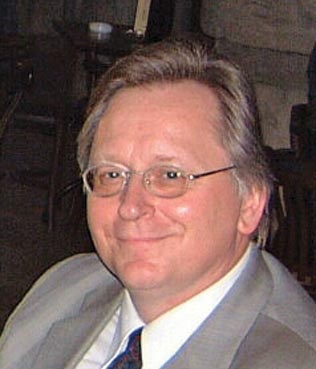 A
TRIBUTE TO CLAYTON R. PAUL
A
TRIBUTE TO CLAYTON R. PAUL


